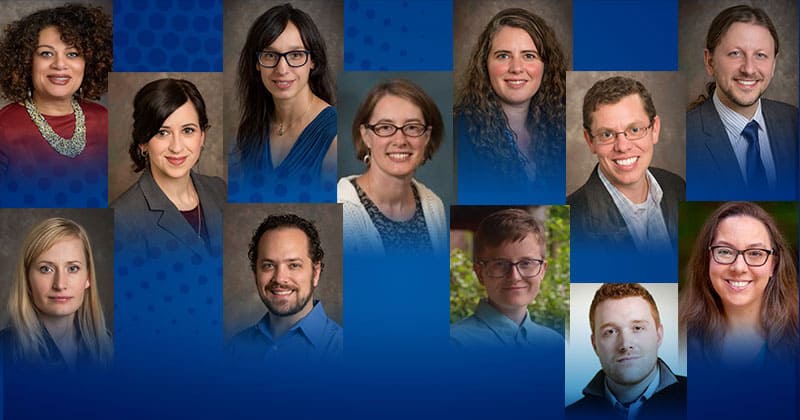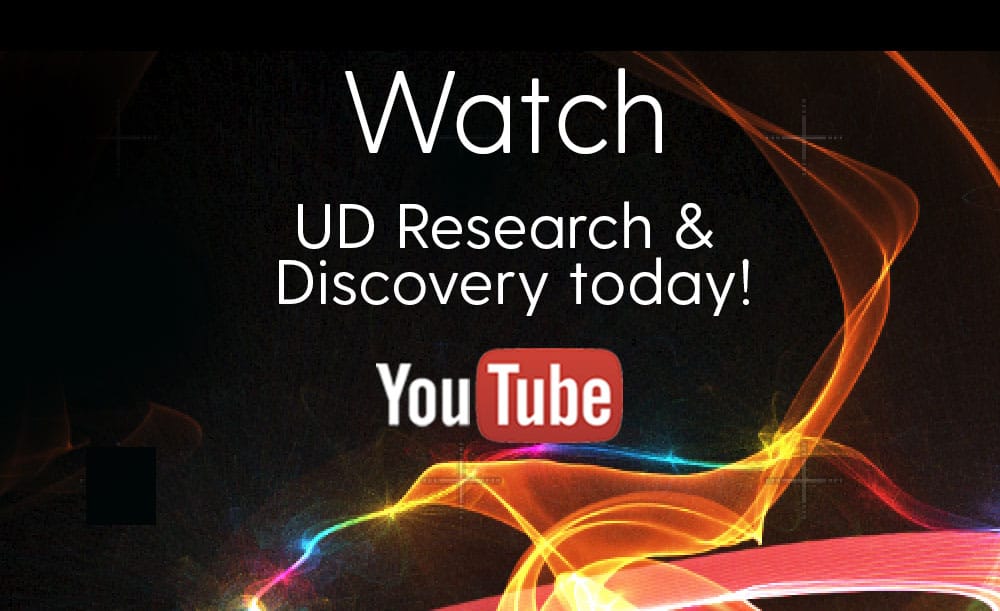RESEARCH
DISCOVERY
A Blog Devoted to UD Innovation, Excellence & Scholarship
FUNDING
12 Receive General University Research Grants
Projects awarded in humanities, arts, science and engineering
Faculty winners of UD’s 2020 General University Research grants include, top row, from left: Ann Aviles, Federica Bianco, Sarah Curtiss, Greg Dobler; middle row, from left: Christina Areizaga Barbieri, Eve Buckley, Jonathan Cox; bottom row, from left: Sarah DeYoung, Colton Lynner, Brooke Jamieson Stanley, Tyler Van Buren and Teomara Rutherford.
The merit-based grants, awarded by the Research Office, provide $15,000 in funding per project.
“General University Research grants are designed to assist faculty, especially those early in their academic careers, with research, scholarly and creative projects,” said Charles G. Riordan, vice president for research, scholarship and innovation. “This funding may support faculty in a variety of ways, whether to explore new ideas, access critical resources to bring a project to completion, or prove a concept that could seed a larger project. We wish these investigators much success and look forward to the outcomes of their work.”
- Ann M. Aviles, assistant professor in the Department of Human Development and Family Sciences, will examine the relationship between housing instability, experiences with violence, health and well-being in a street-identified community of Black youth and adults in the Northside and Westside neighborhoods of Wilmington, Delaware. Expanding on a larger project funded by the National Institutes of Health, she will conduct a series of individual and group interviews, and field observations for secondary data analysis. The findings will contribute to our understanding of health and well-being for Black individuals and communities who have historically been disenfranchised and marginalized, specifically those experiencing housing instability.
- Christina Areizaga Barbieri, assistant professor in the School of Education, will assess the benefits of two different instructional strategies on elementary school students at risk for mathematics learning difficulties. Her prior work shows that explaining common math errors — called errorful instruction — has been shown to improve math learning in general. She will compare this approach to standard instructional practices used with students with learning difficulties. The findings will lead to improved learning opportunities for those who most need them.
- The Rubin Observatory Legacy Survey of Space and Time (LSST), with its 3.2 billion-pixel camera for imaging faint astronomical objects, will generate 20 terabytes of data every night for a decade starting in 2023. Federica Bianco, assistant professor in the Department of Physics and Astronomy and the Joseph R. Biden, Jr. School of Public Policy and Administration, will use cutting-edge artificial intelligence techniques to capture “light echoes.” These faint reflections of ancient stellar explosions off interstellar dust will advance her quest to study the evolution of the Milky Way.
- Eve Buckley, associate professor in the Department of History, is working in five archives within the U.S. that hold the papers of individuals who were central to defining overpopulation when that first became a widespread global concern during the early decades of the Cold War. The research, the basis of a book-length study, will complement work she did two summers ago in northeast Brazil on the papers of physician and nutritionist Josué de Castro, a prominent opponent of overpopulation discourse from 1948 until his death in 1973.
- Arriving over the last 40 years, refugees and immigrants living in Idaho represent over 80 countries. Jonathan Cox, assistant professor in the Department of Art and Design, is working on a collaborative multidisciplinary project titled “What’s Left Behind: What Lies Ahead” that will record and disseminate their stories, as well as those of Native Americans who have been displaced from their ancestral lands. The project will allow these participants to share their journeys, arrivals to the U.S. and current status through their own eyes.
- Children with autism can be very selective about the food they will eat — even down to a particular brand or color — and may have ritualistic eating habits, making mealtimes stressful. To reduce the stress, Sarah Curtiss, assistant professor in the School of Education, has developed an online toolkit called Mealtimes on the Spectrum, based on interviews with families and observations of their meals. She is now evaluating the toolkit’s effectiveness. Autistic children face health risks from poor eating — under consumers may have problems such as poor bone growth and vitamin deficiencies. Conversely, autistic children are at higher risk of obesity.
- Sarah DeYoung, assistant professor in the Department of Sociology and Criminal Justice and the Disaster Research Center, is working to identify key factors for bolstering safe infant feeding in disasters and emergencies. Her project also will study the impact of the coronavirus (COVID-19) on infant feeding. Prior work from the 2016 Fort McMurray wildfire in Canada and from the 2015 Nepal (Gorkha) earthquake indicates that disaster evacuations reduce breastfeeding rates and may increase the use of infant formula during a time when clean water may not be accessible. Identifying inhibiting factors for sustained breastfeeding and safe artificial feeding during and after disasters can inform new interventions and policies used in mass care and evacuation scenarios.
- Gregory Dobler, assistant professor in the Joseph R. Biden, Jr. School of Public Policy and Administration and the Department of Physics and Astronomy, will expand his Urban Observatory (UO) to Freetown, Sierra Leone. The UO is a place where data science, machine learning and computer vision techniques facilitate city operations, from monitoring energy consumption to air pollution. The UO deployed in Freetown with the local government will monitor urban lighting to address their urgent need to assess the health of their power distribution network and provide real-time detection of power outages.
- While earthquakes and volcanic eruptions are spatially linked, can one trigger the other? An excellent natural laboratory to test this hypothesis lies in Ecuador, where the Cotopaxi volcano has been erupting since 2015.Colton Lynner, assistant professor in the Department of Earth Sciences, will use seismic methods to measure daily changes in stress state of the crust surrounding the volcano to study whether a large nearby earthquake in 2016 triggered changes in the eruptive behavior of Cotopaxi.
- Although technology holds promise in improving math learning, teachers face challenges integrating it in the classroom, especially managing student motivation. The implications are real — students who experience positive emotions when interacting with the technology are more likely to persist on challenging tasks and learn more. In her project, Teomara Rutherford, assistant professor in the School of Education, will examine teachers interacting with students while they engage with the mathematics learning software, Spatial Temporal (ST) Math. This effort will lay the groundwork for future research on a little-studied area and develop new tools to aid teachers.
- Brooke Jamieson Stanley, assistant professor of environmental humanities in the Department of English, will pursue archival research in South Africa to complete Intimate Planet: Consumption and the Global Environmental Novel. Their book is an interdisciplinary investigation, with each chapter examining a novelist in conjunction with a movement in environmental justice activism focusing on the global agro-food system. They are spotlighting writers of color from South Africa, South Asia and the United States in the work.
- Tyler Van Buren, assistant professor in the Department of Mechanical Engineering, is exploring the fluid mechanics involved in generating platelets from megakaryocytes in bone marrow. While little is known about the precise flow mechanisms, there is evidence that unsteady flow structure and shear can promote platelet production. He will detail the interaction of a megakaryocyte with a range of unsteady flow types and assess platelet density in real-time using microscopic visualization and measurement techniques. A goal will be to determine if the findings can be leveraged to enhance platelet production in technologies for donation or even to develop new treatments.






